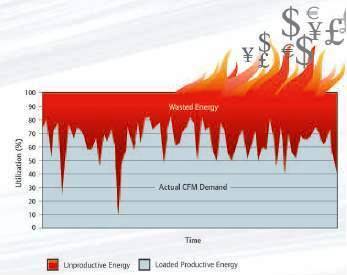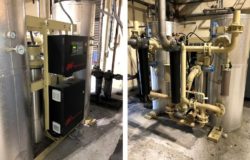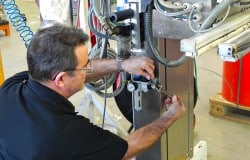Whether the burning platform is to achieve energy savings or to play an active role in the transition to a low carbon economy, more and more Corporates are instructing their plants to reduce energy demand and improve efficiency.
With increased awareness of energy costs as well as the effects of greenhouse gas emissions, the industrial and manufacturing sectors are seeking smarter ways to achieve energy efficiencies and savings. Tellingly, new roles, with titles like Energy Engineer, are being created as the pressure to save on energy costs mounts.
As a result, plants and production facilities are placing greater attention on the energy efficient use of compressed air for very good reasons. On average, compressed air systems use 10% of the energy consumed by a production facility. Plus, energy costs, over the 10 yr life cycle of an air compressor, represent 80% of the cost of ownership.
With statistics like that, we know that even small improvements to a compressed air system can help maximise overall plant energy efficiency. However, we have found that many organisations are missing the chance to improve energy savings with some relatively low cost projects for increasing energy efficiency.
For instance, Leakage management is the single most cost effective measure you can take in a compressed air system in order to save energy and reduce running costs. Addressing leakages should be the number one priority before ever considering an investment in additional capacity or more efficient compressors.
Compressed air is energy. Leaking air lines, couplings and hoses are simply put, sources of energy waste. The majority of companies have a leakage rate of more than 20%. Apart from being completely unnecessary, it is expensive and contributes to your CO2 emissions. In a LeekSeek™ Leakage Management Programme, your leakage level will be reduced to less than 5%.
One of our clients achieved savings of over €30,000 after undertaking a leakage management programme. Click here to find out how.
Of course, it goes without saying that no savings will be made as a result of a leakage survey only. Repairs must be carried out as quickly as possible after the completion of the survey to reduce consumption and drive down energy costs. O’Neill Industrial, as a distributor and stockist of many leading brands of Pneumatic components, can supply the materials required for repair work. In addition, we can provide repair technicians to manage the Leakage repair work or complete the repairs if necessary.
Here are some other factors to consider when looking at smart energy saving options across a compressed air system…
Products – select the right products for the job. Savings come from selecting the right compressor to match your business needs. Manufacturers should regularly review the suitability of their compressed air system for their particular operation and evaluate whether their air compressors need to be overhauled or replaced.
Energy efficiency is one of the most essential considerations in judging the successful operation of a compressed air system. If an air compressor is operating inefficiently, in the long run, it’s probably costing you more than the purchase price of a new compressor.
Ingersoll Rand Air Compressors offer the very best of time-proven designs and technologies with new, advanced features that ensure the highest levels of reliability, efficiency and productivity available.
Monitoring – Measuring and monitoring your compressed air system’s energy consumption, flow rates and operating air pressure is essential. Operating more compressors than necessary, operating the wrong combination of compressors and/or maintaining elevated system pressures all contribute to energy waste.
To counter this, a number of our clients have installed theX8i and are now cutting operating costs with their existing system. The Ingersoll Rand X-Series System Automation eliminates waste by managing up to eight (8) positive displacement compressors simultaneously. This can include compressors of different capacities, different types (fixed speed, variable speed, variable capacity), and in any combination.
Heat Recovery – The overwhelming majority of the energy used to run a compressor is converted into heat through the compression process, and this heat is normally left to absorb into the cooling cycle. A heat recovery system will reduce your energy costs.
Pressure Control – The use of IntelliFlow Controller effectively uses system storage to compensate for high, random air usage (events) and avoids the need to increase system pressure.
Flow Meters – Flow Meters provide a cost-effective way to monitor compressed-air usage throughout an industrial plant. These Flow Meters make localised metering of air usage a practical way to manage a compressed-air system.
Maintenance – Proper maintenance schedules offer peace of mind and protect against breakdowns. O’Neill Industrial has a team of multi-skilled highly trained engineers available to respond to our customers 24 hours a day, 365 days a year. We also offer the SelectCARE programme.
To keep your systems running at maximum efficiency 24 hours a day, 7 days a week, Ingersoll Rand has designed SelectCARE, a one to five-year or six to ten-year all-in-one maintenance program for rotary compressors and air dryers. A fixed fee covers all costs. There are no hidden extras.
SelectCARE ensures that your compressed air system is maintained in accordance with the manufacturer’s specifications and within the manufacturer’s schedule. This drastically reduces the possibility of unforeseen stoppages and ensures the uptime of your facility.
Organisations can achieve significant savings in compressed air systems through improved energy management. Very often, small improvements can make a big difference.
Besides energy savings, increasing the energy efficiency of a Compressed Air System may lead to other significant benefits for the enterprise. Applying energy saving measures generally means more accurate monitoring of the compressed air system and results in better outcomes – for instance, decreased breakdowns of production equipment, avoiding the loss of raw materials or other inputs, the longer life cycle of pneumatic devices and higher reliability of the system. Reduction in energy consumption will also lower the emissions of dangerous and polluting substances, which will lessen the influence on the environment. Often, these benefits are more valuable than the energy savings achieved.
For more information about energy saving solutions for compressed air systems, please contact Austin O’Neill, O’Neill Industrial on 061 – 313888






